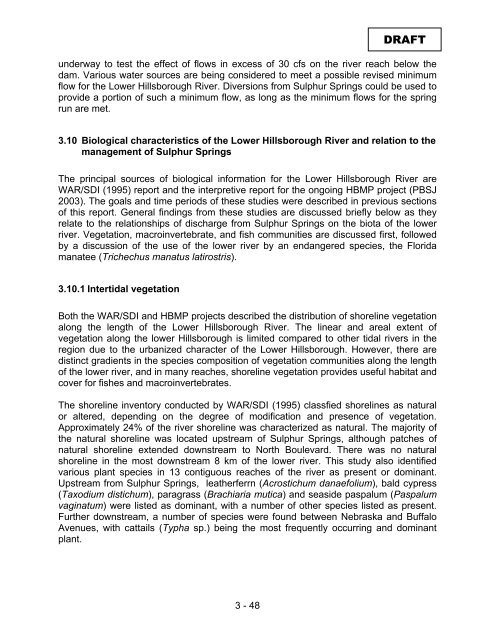The Determination of Minimum Flows for Sulphur Springs, Tampa
The Determination of Minimum Flows for Sulphur Springs, Tampa
The Determination of Minimum Flows for Sulphur Springs, Tampa
Create successful ePaper yourself
Turn your PDF publications into a flip-book with our unique Google optimized e-Paper software.
DRAFT<br />
underway to test the effect <strong>of</strong> flows in excess <strong>of</strong> 30 cfs on the river reach below the<br />
dam. Various water sources are being considered to meet a possible revised minimum<br />
flow <strong>for</strong> the Lower Hillsborough River. Diversions from <strong>Sulphur</strong> <strong>Springs</strong> could be used to<br />
provide a portion <strong>of</strong> such a minimum flow, as long as the minimum flows <strong>for</strong> the spring<br />
run are met.<br />
3.10 Biological characteristics <strong>of</strong> the Lower Hillsborough River and relation to the<br />
management <strong>of</strong> <strong>Sulphur</strong> <strong>Springs</strong><br />
<strong>The</strong> principal sources <strong>of</strong> biological in<strong>for</strong>mation <strong>for</strong> the Lower Hillsborough River are<br />
WAR/SDI (1995) report and the interpretive report <strong>for</strong> the ongoing HBMP project (PBSJ<br />
2003). <strong>The</strong> goals and time periods <strong>of</strong> these studies were described in previous sections<br />
<strong>of</strong> this report. General findings from these studies are discussed briefly below as they<br />
relate to the relationships <strong>of</strong> discharge from <strong>Sulphur</strong> <strong>Springs</strong> on the biota <strong>of</strong> the lower<br />
river. Vegetation, macroinvertebrate, and fish communities are discussed first, followed<br />
by a discussion <strong>of</strong> the use <strong>of</strong> the lower river by an endangered species, the Florida<br />
manatee (Trichechus manatus latirostris).<br />
3.10.1 Intertidal vegetation<br />
Both the WAR/SDI and HBMP projects described the distribution <strong>of</strong> shoreline vegetation<br />
along the length <strong>of</strong> the Lower Hillsborough River. <strong>The</strong> linear and areal extent <strong>of</strong><br />
vegetation along the lower Hillsborough is limited compared to other tidal rivers in the<br />
region due to the urbanized character <strong>of</strong> the Lower Hillsborough. However, there are<br />
distinct gradients in the species composition <strong>of</strong> vegetation communities along the length<br />
<strong>of</strong> the lower river, and in many reaches, shoreline vegetation provides useful habitat and<br />
cover <strong>for</strong> fishes and macroinvertebrates.<br />
<strong>The</strong> shoreline inventory conducted by WAR/SDI (1995) classfied shorelines as natural<br />
or altered, depending on the degree <strong>of</strong> modification and presence <strong>of</strong> vegetation.<br />
Approximately 24% <strong>of</strong> the river shoreline was characterized as natural. <strong>The</strong> majority <strong>of</strong><br />
the natural shoreline was located upstream <strong>of</strong> <strong>Sulphur</strong> <strong>Springs</strong>, although patches <strong>of</strong><br />
natural shoreline extended downstream to North Boulevard. <strong>The</strong>re was no natural<br />
shoreline in the most downstream 8 km <strong>of</strong> the lower river. This study also identified<br />
various plant species in 13 contiguous reaches <strong>of</strong> the river as present or dominant.<br />
Upstream from <strong>Sulphur</strong> <strong>Springs</strong>, leatherferrn (Acrostichum danaefolium), bald cypress<br />
(Taxodium distichum), paragrass (Brachiaria mutica) and seaside paspalum (Paspalum<br />
vaginatum) were listed as dominant, with a number <strong>of</strong> other species listed as present.<br />
Further downstream, a number <strong>of</strong> species were found between Nebraska and Buffalo<br />
Avenues, with cattails (Typha sp.) being the most frequently occurring and dominant<br />
plant.<br />
3 - 48

















